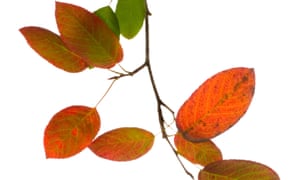
Ispend all summer fascinated by the things beneath my feet, but by autumn my gaze rises. In these darker months, I plan routes and take detours just to look at my favourite trees: a neighbour’s front garden with interesting bark to inspect, a brilliant shock of autumn colour or a car park with an unusual specimen – I hunt them all out hungrily.
Every garden needs a tree or two. The right tree will bring height, seasonal interest and, with that, a snack or two for wildlife. I recently watched a blackbird go dizzy with excitement when a juneberry, Amelanchier lamarckii, was planted in a London front garden, realising it was in for a treat with all those dark, lustrous berries to eat.
Juneberries (aka snowy mespilus) make wonderful garden trees. In early summer, they are covered in white blossom that’s perfect for bees; in late summer, this turns to berries that taste remarkably like blueberries; and by autumn the whole tree turns a buttery yellow.
A 2-3m tree of this nature won’t be cheap, especially if you want an airy, effortless Chelsea-esque look where the stems have been crown-lifted a metre or so. Such a tree will easily set you back a grand or more, and will require several people to lever it into place. If, however, you can be patient and are prepared to do the pruning yourself over a number of years (left to itself, a juneberry is quite a straggly thing), buy a 1.5m-tall specimen for £160 or so. Or if you are on a tight budget but have grand dreams, get some seed from Agroforestry Research Trust, and in 15 years you’ll have the great satisfaction of having grown something of a decent stature.
Juneberry can be grown as a large shrub – I’ve seen it successfully made into a hedge or multi-stemmed tree that can eventually reach 7m tall. Amelanchier xgrandiflora ‘Robin Hill’ has a dense, upright crown and can be grown as a single-stemmed tree.
Another tree that is ornamental, seasonal and suitable for smaller gardens is the snake-bark maple, Acer capillipes, with rivulets of white on green snaking down its bark; in autumn, its leaves burnish a brilliant red. It grows to 5-8m in height. Or there’s ornamental crab apple, such as Malus trilobata, which has a tight, pyramidal canopy and distinct lobed leaves that turn bright red in autumn. M.‘Evereste’ has bright red crab apples and a similarly tight habit.
I’d also love to see more front gardens growing the Cornelian cherry, Cornus mas, a dogwood from central Europe. If you want nothing but tree, you can grow it as a large, bushy shrub with branches from ground level, or you can buy it as a single-stemmed specimen. In early spring, it is covered in bright yellow flowers that appear before the leaves, then in summer there are edible, though sour, cherries. In autumn, the leaves turn a perfect sort of deep purple.
[Source:- The Gurdian]
